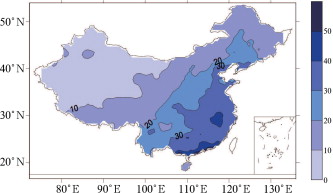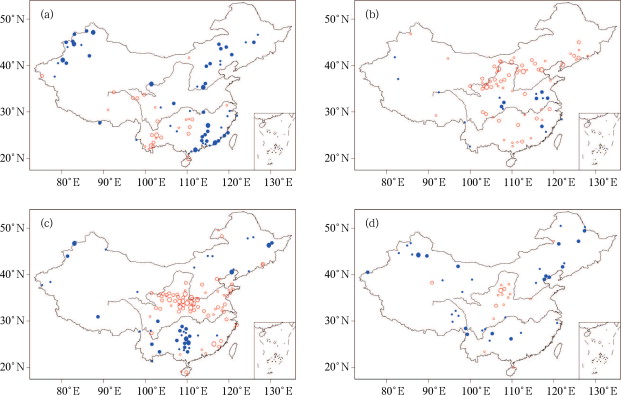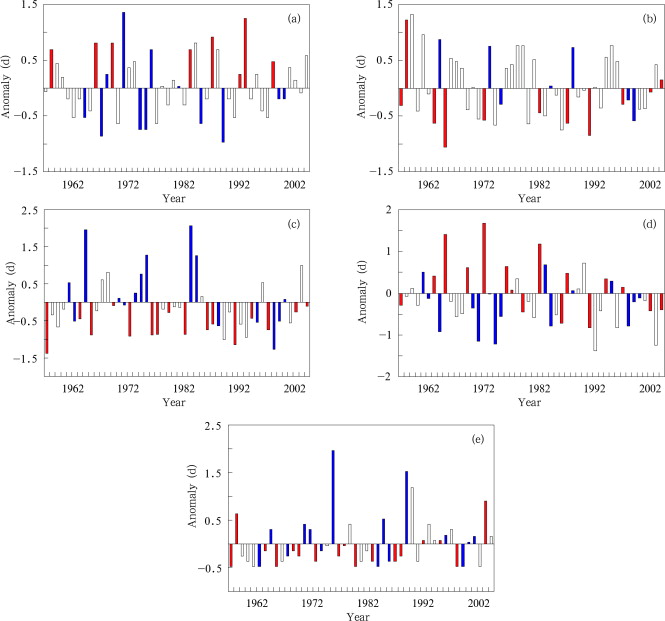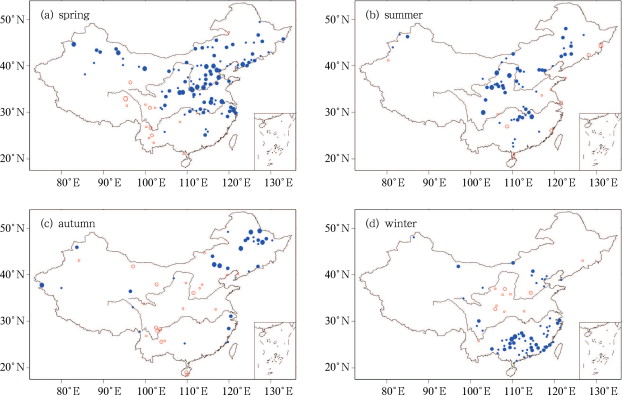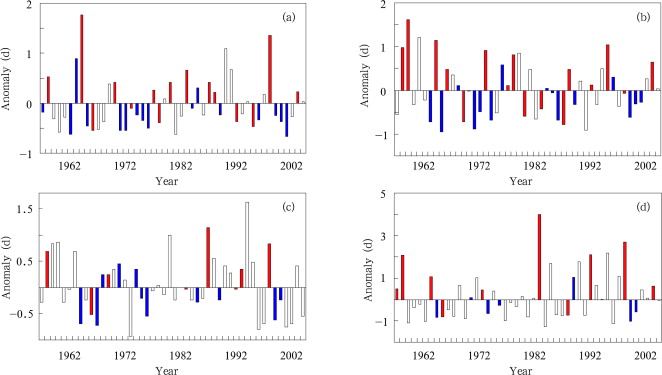Abstract
Based on a daily precipitation observation dataset of 743 stations in China from 1951–2004, the Γ distribution function is used to calculate the probability distribution of daily precipitation and to define extreme precipitation events. Based on this, the relationship of ENSO and the frequency of extreme precipitation events is studied. Results reveal that ENSO events have impact on extreme precipitation events, with different magnitudes at different regions and seasons. In general, during winter and spring, extreme precipitation events occur more often during El Niño events than during La Niña events. While during summer and autumn, the opposite is found. The relationship of a two season-lag ENSO and extreme precipitation frequency shows different pattern. Extreme precipitation events occur more often in several regions if an ENSO warm phase happened in the central-eastern tropical Pacific two seasons before. No similar impacts of El Niño and La Niña on the frequency of extreme precipitation events are found.
Keywords
extreme precipitation ; Γ distribution function ; ENSO ; Niño 3.4 ; sea surface temperature
1. Introduction
It is revealed that significantly increasing trends in precipitation over large areas of western China are observed for the last decades. In the monsoon regions of eastern China, the trend is also increasing in the Yangtze River Basin but decreasing in North China. As for the average of whole China, the amount of annual precipitation changes little, but rainfall days decrease noticeably [ Zhai et al., 2005 ]. It implies that the precipitation intensity strengthens, and drought and flood events occur more frequently [ Zhai et al., 1999 ]. The recent study by Zhai et al. [2007] shows that there is a close relationship between the change of precipitation amounts and extreme precipitation frequency. Extreme precipitation events become more frequent in western Northwest China, the Yangtze River and the region south of the Yangtze River, and clearly decrease in North China. But the percentages of the extreme precipitation amounts among total precipitation increase in all these regions.
China is influenced by typical continental monsoon climate, most precipitation mainly happens in summer during the Southwest and Southeast Monsoon. In eastern China, the rain belt advances northward seasonally, which is related to the seasonal northward shift of the western North Pacific subtropical high (WNPSH). Zhao [1996] pointed out that the impact of the eastern tropical Pacific sea surface temperature (SST) on WNPSH generally lags 4–6 months. Furthermore, changes in the WNPSH will influence the temperature and precipitation in China. ENSO is a strong signal of decadal climate changes in ocean-atmosphere systems in the tropical Pacific region. Many studies have revealed its indirect effect on precipitation in China [ Chen, 1977 and Zhao, 1999 ; Liao and Zhao, 1992 ; Zou and Ni, 1997 , Gong and Wang, 1998 , Jin and Tao, 1999 , Zhang and Ding, 2004 and Zhu et al., 2007 ]. Liao and Zhao [1992] indicated that El Niño events that take place in different seasons can have different impacts on summer precipitation in China. The rain belt always stays in the Huaihe River valley if El Niño takes place in spring, and in the Yangtze River and the southern region if El Niño occurs in summer and autumn. Most researches investigate the ENSO lagging impact on precipitation in China, but few studies focus on the relationship between ENSO and precipitation occurring at the same time. Ropelewski and Bell [2008] found for South America that precipitation amounts were obviously different in cold ENSO phase and warm ENSO phase, and that the phenomenon was also varying in different seasons. Zhang and Ding [2004] revealed that there is a significant negative correlation between summer SST in Niño1+2 region and summer extreme precipitation in eastern China, but the relationship between strong ENSO signals and extreme precipitation was not presented yet. In this paper, SST index in Niño3.4 region (5°S-5°N, 170°–120°W) is chosen as the strong ENSO signal, and its simultaneous impact on extreme precipitation frequency in China is studied. Meanwhile, considering the lagging response of climate to ENSO, the relationship between strong ENSO signal and the frequency of extreme precipitation in China that lags the ENSO signal is also studied.
2. Data and methodology
The precipitation data analyzed here is from a dataset of daily precipitation observations from the China Meteorological Administration (CMA), which is available for 743 Chinese stations covering the period 1951–2004. The quality control has been done. Data for the optimal interpolative SST for 1982–2004 is provided by the National Centers for Environmental Prediction (NCEP). In order to improve the short time sequence of NCEP’s SST data, data on SST during 1951–1981 provided by COADS (American Marine integrated data sets) is also used.
In this study, the Γ distribution function is used to define extreme precipitation events. Here, the historical sequence of daily precipitation is simulated by the Γ distribution function, and then the value of 95% percentile (probability density) is considered as the station precipitation extreme threshold.
The t -test is used to decide the differences between extreme precipitation frequencies in the El Niño phase and the La Niña phase.
3. Simulation of daily precipitation and extreme precipitation
Figure 1 displays the Γ distribution probability density curves and the observed frequency curves for daily precipitation in Beijing and Guangzhou during 1951–2004. The two curves in each panel illustrate the skewness and vary consistently. Only the first point on the x axis, when x = 0.5 mm or 0 < x < 1 mm, the value of the Γ distribution density function is obviously smaller than the sample frequency value. This indicates that the Γ distribution density function can reflect the frequency of drizzle, but cannot reflect the extent enough. When x > 1 mm, the two curves match well. Overall, the Γ distribution function can objectively reflect the actual frequency of rainfall.
|
|
|
Figure 1. Γ distribution probability density functions and observed frequencies of daily precipitation for (a) Beijing and (b) Guangzhou |
Figure 2 shows the spatial distribution of the thresholds of daily extreme precipitation in China based on the simulation of the Γ distribution function. The threshold decreases progressively from south-east to north-west. The maximum value is found in the coastal areas of South China and the lower Yangtze River, with above 50 mm in South China. Minimum value is located in northwest regions, basically below 10 mm. The spatial distribution model conforms to rainfall climatic distribution in China.
|
|
|
Figure 2. Thresholds of daily extreme precipitation (mm) in China simulated by the Γ distribution function (1951–2004, data for Taiwan province are not available) |
4. Relationship between ENSO and frequency of extreme precipitation
The equatorial central-eastern Pacific Ocean SST anomalies are divided into neutral, warm, and cold. If the seasonal average in the Niño3.4 SST index is above 0.5°C (below −0.5°C), this year will be defined as warm (cold) year (Table 1 ). For each season, it can then be considered as an El Niño (La Niña) phase year.
| Spring | Summer | Autumn | Winter | |||||||||||||
|---|---|---|---|---|---|---|---|---|---|---|---|---|---|---|---|---|
| Abnormally warm year | 1958, | 1966, | 1969, | 1957, | 1958, | 1963, | 1951, | 1953, | 1957, | 1963, | 1965, | 1957, | 1958, | 1963, | 1965, | 1968, |
| 1983, | 1987, | 1992, | 1965, | 1972, | 1982, | 1969, | 1972, | 1976, | 1977, | 1979, | 1969, | 1972, | 1976, | 1977, | 1979, | |
| 1993, | 1998 | 1987, | 1991, | 1997, | 1982, | 1986, | 1987, | 1991, | 1994, | 1982, | 1986, | 1987, | 1991, | 1994, | ||
| 2002, | 2004 | 1997, | 2002, | 2004 | 1997, | 2002, | 2004 | |||||||||
| Abnormally cold year | 1955, | 1956, | 1964, | 1954, | 1955, | 1956, | 1954, | 1955, | 1956, | 1961, | 1962, | 1954, | 1955, | 1962, | 1964, | 1967, |
| 1967, | 1968, | 1971, | 1964, | 1970, | 1973, | 1964, | 1970, | 1971, | 1973, | 1974, | 1970, | 1971, | 1973, | 1975, | 1983, | |
| 1974, | 1975, | 1976, | 1975, | 1988, | 1998, | 1975, | 1983, | 1984, | 1988, | 1995, | 1984, | 1985, | 1988, | 1995, | 1998, | |
| 1985, | 1989, | 1999, | 1999 | 1998, | 1999, | 2000 | 1999, | 2000 | ||||||||
| 2000 | ||||||||||||||||
Note: Spring refers the months March to May, summer is June to August, autumn is September to November, and winter is from last December to February.
4.1. ENSO impacts on frequency of extreme precipitation in the same term
Figure 3 displays the differences of seasonal frequency of extreme precipitation in China of El Niño phases to La Niña phases. In spring, extreme precipitation days in North China, Northeast China, northern Xinjiang and Southeast China are significantly more frequent in El Niño phases than in La Niña phases. In summer, extreme precipitation days in the upper and middle reaches of the Yangtze River, in North China, and in South China are significantly less frequent in El Niño phases than in La Niña phases, while it is vice versa in the Huaihe River valley. In autumn, extreme precipitation days in the Central Plains are less frequent in El Niño phases than in La Niña phases, while it is reverse in Guangxi, Guizhou and Hunan. In winter, the frequencies of extreme precipitation are significantly more frequent in northern Xinjiang, Northeast China and the upper reaches of the Yangtze River during El Niño phases than during La Niña phases, while it is vice versa in eastern Northwest China. These results make clear that the strong ENSO signal has different impacts on the frequency of extreme precipitation in different regions and different seasons in China. Extreme precipitation events happen more often in winter and spring during El Niño phases, and are more frequent in summer and spring during La Niña phases.
|
|
|
Figure 3. Differences in the seasonal frequency of extreme precipitation in China between El Niño and La Niña phases during 1951–2004, (a) spring, (b) summer, (c) autumn, (d) winter (blue represents more frequent in El Niño phase, red represents more frequent in La Niña phase; at 99% (large circles), 95% (medium circles), and 90% (small circles) confidence level, respectively) |
Figure 4 presents variations in anomalies of seasonal extreme precipitation days in five regions of China during 1957–2004. The regions are chosen due to their significant differences of extreme precipitation frequency of El Niño phases to La Niña phases. In northern Xinjiang, the extreme precipitation days are above normal during an El Niño phase in spring, while it is mostly below normal during a La Niña phase in spring. That means the impact of an ENSO warm phase on extreme precipitation in northern Xinjiang in spring is more obvious than that of an ENSO cold phase. In the Yellow River basin and northern North China, summer extreme precipitation days are above (below) normal in La Niña (El Niño) phases. But occasionally, obvious frequencies above or below normal emerge in SST normal summer (such as 1959 and 1989), which means that the strong ENSO signal is not the only factor that influences extreme precipitation frequency at these regions. In Shaanxi, Henan, and Hubei, autumn extreme precipitation days are all below normal during El Niño phases, and basically above normal in La Niña phases (9 of 15 autumns with La Niña status). This is reverse in Hunan, Guizhou, and Guangxi (in autumn), here the frequencies are mostly above (below) normal during El Niño (La Niña) phases. In eastern Northwest China, winter extreme precipitation days are generally above (below) normal in La Niña (El Niño) phases, especially in the winter of 1975 and 1988.
|
|
|
Figure 4. Variation of seasonal extreme precipitation days in five regions of China during 1957–2004, (a) northern Xinjiang (82°–89°E, 45°–49°N) in spring, (b) Yellow River basin (103°–113°E, 35°–42°N) and northern North China (113°–117°E, 38.5°–42°N) in summer, (c) Shaanxi-Henan-Hubei (103°–113°E, 32°–36°N) in autumn, (d) Hunan-Guizhou-Guangxi (107°–112°E, 23°–29°N) in autumn, (e) eastern Northwest China (107°–110°E, 35°–38°N) in winter (solid red columns stand for El Niño phases, blue columns stand for La Niña phases, and hollow columns stand for normal phases) |
4.2. Relationship between strong ENSO signal and frequency of extreme precipitation that lags ENSO signal
Figure 5 presents the differences of seasonal frequency of extreme precipitation in China of El Niño phases to La Niña phases during 1951–2004 with extreme precipitation events that lag the ENSO signal by two seasons. In most of the regions with statistically significant differences, warm/cold strong ENSO signals cause more/less frequent extreme precipitation events two seasons later. For example, the Yangtze River basin and most regions of North China in spring, the Yellow River and parts of Northeast China in summer, northern Northeast China in autumn, and most regions of South China in winter. In these regions, the frequencies of extreme precipitation are statistically significantly more (less) frequent with extreme precipitation events lagging El Niño (La Niña) phases by two seasons.
|
|
|
Figure 5. Differences in the seasonal frequency of extreme precipitation lagging two seasons of ENSO signals in China between El Niño phase and La Niña phase during 1951–2004 (the legends are same as those in Figure 3 ) |
Figure 6 presents anomalies of seasonal extreme precipitation days in four regions with extreme precipitation days significant different between El Niño and La Niña phase (North China, parts of the Yellow River basin, Northeast China, and South China) during 1957–2004. The anomalies present the seasonal frequencies of extreme precipitation according to a warm (cold) ENSO phase which occurred two seasons ago.
|
|
|
Figure 6. Same as Figure 4 but for extreme precipitation events which lag the ENSO signal by two seasons, (a) North China (110°–120°E, 35°–40°N) in spring, (b) parts of the Yellow River basin (104°–110°E, 35°–40°N) in summer, (c) Northeast China (121°–130°E, 44°–50°N) in autumn, and (d) South China (109°–120°E, 21°–28°N) in winter |
5. Conclusions
(1) The Γ distribution function can objectively refleet the actual frequency distribution of rainfall, and it is applicable to simulate the threshold of extreme precipitation.
(2) The strong ENSO signal causes different impacts on the frequency of extreme precipitation in different regions in China and at different seasons. Generally, extreme precipitation events happen more often in El Niño phases during winter and spring, and more often in La Niña phases during summer and autumn.
(3) As for the extreme precipitation events which lag the ENSO signal by two seasons, strong warm (cold) ENSO signals mostly show more (less) frequent extreme precipitation. Hence, this is different to the relationship between ENSO and the frequency of extreme precipitation at the same time.
(4) The impacts extent of strong warm/cold ENSO signals on extreme precipitation events are not the same in China. It should be pointed out that the ENSO signal is not the only factor that influences the frequency of extreme precipitation, but also other climate factors may have effects.
Acknowledgements
This paper is supported by the program under Grant No. 2007BAC29B04.
References
- Chen, 1977 L. Chen; The influence of eastern equatorial Pacific temperature anomaly on tropical atmospheric circulation and precipitation in flood season in China; Chinese Journal of Atmospheric Sciences(in Chinese) (1) (1977), pp. 1–12
- Gong and Wang, 1998 D. Gong, S. Wang; Impact of ENSO on the seasonal rainfall in China; Journal of Natural Disasters (in Chinese), 7 (4) (1998), pp. 44–52
- Jin and Tao, 1999 Z. Jin, S. Tao; A study on the relationships between ENSO cycle and rainfalls during summer and winter in eastern China; Chinese Journal of Atmospheric Sciences (in Chinese), 23 (6) (1999), pp. 663–672
- Liao and Zhao, 1992 Q. Liao, Z. Zhao; A seasonal forecasting scheme on precipitation distribution in summer in China; Quarterly Journal of Applied Meteorology (in Chinese), 3 (1992), pp. S1–S9
- Ropelewski and Bell, 2008 C.F. Ropelewski, M.A. Bell; Shifts in the statistics of daily rainfall in South America conditional on ENSO phase; J. Climate, 21 (2008), pp. 849–865
- Zhai et al., 1999 P. Zhai, F. Ren, Q. Zhang; Detection of trends in China’s precipitation extremes; Acta Meteorological Sinica(in Chinese), 57 (2) (1999), pp. 208–216
- Zhai et al., 2007 P. Zhai, C. Wang, W. Li; A review on study of change in precipitation extremes; Adv. Clim. Change Res. (in Chinese), 3 (3) (2007), pp. 144–148
- Zhai et al., 2005 P. Zhai, X. Zhang, H. Wan, et al.; Trends in total precipitation and frequency of daily precipitation extremes over China; J. Climate, 18 (4) (2005), pp. 1096–1107
- Zhang and Ding, 2004 Y. Zhang, Y. Ding; The teleconnection between summer extreme precipitation over east China and north Pacific SST; Journal of Nanjing Institute of Meteorology (in Chinese), 27 (2) (2004), pp. 244–252
- Zhao, 1996 Z. Zhao; Impact of El Niño events on atmospheric circulations in the Northern Hemisphere and precipitation in China; Chinese Journal of Atmospheric Sciences (in Chinese), 20 (4) (1996), pp. 422–428
- Zhao, 1999 Z. Zhao; Drought, Flood and Circulation in Summer in China (in Chinese), China Meteorological Press (1999), p. 297
- Zhu et al., 2007 Y. Zhu, X. Yang, X. Chen; Interdecadal variation of the relationship between ENSO and summer interannual climate variability in China; Journal of Tropical Meteorology (in Chinese), 23 (2) (2007), pp. 105–116
- Zou and Ni, 1997 L. Zou, Y. Ni; Impact of ENSO on the variability of the summer monsoon over Asia and the summer rainfall in China; Journal of Tropical Meteorology (in Chinese), 13 (4) (1997), pp. 306–314
Document information
Published on 15/05/17
Submitted on 15/05/17
Licence: Other
Share this document
Keywords
claim authorship
Are you one of the authors of this document?

